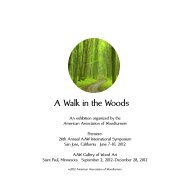The World Turns: AAW@25 - Gallery of Wood Art
The World Turns: AAW@25 - Gallery of Wood Art
The World Turns: AAW@25 - Gallery of Wood Art
You also want an ePaper? Increase the reach of your titles
YUMPU automatically turns print PDFs into web optimized ePapers that Google loves.
<strong>The</strong> <strong>World</strong> <strong>Turns</strong>: <strong>AAW@25</strong><br />
During the past three decades, Canada’s Michael Hosaluk has been a leading figure in inspiring and expanding the<br />
field internationally through his perception-challenging artwork and his time spent organizing and traveling to demonstrate at<br />
symposia. “I have always believed we should push the limits <strong>of</strong> interpretation in the field <strong>of</strong> woodturning,” Hosaluk says. “I was<br />
determined from the beginning to contribute to the growth <strong>of</strong> this field through my work, and what still motivates me to contribute<br />
are the people and the fun I have associating with them.”<br />
Graeme Priddle attended a three-day conference <strong>of</strong> New Zealand’s National Association <strong>of</strong> <strong>Wood</strong>turners, where<br />
Hosaluk’s approach made clear the potential <strong>of</strong> the process. “I had been turning for three years, mainly knocking out bowls and<br />
simple stuff from pretty wood to keep the bills paid,” Priddle recalls. “<strong>The</strong> conference featured international turners including Al<br />
Stirt and Michael Hosaluk. I spent 90 percent <strong>of</strong> the conference with Hosaluk, as his creative freedom and openness to cut,<br />
subtract, add, paint, burn, and embellish captured my imagination.” Soon after, Priddle received an invitation from the AAW<br />
to show a piece in Growth Through Sharing, the first AAW exhibition, curated in conjunction with the 10th anniversary AAW<br />
symposium in Greensboro, North Carolina. “Attending the Greensboro symposium was intimidating because I had never seen so<br />
many woodturners in one place and so many whose work I had only admired in magazines,” Priddle says. “Everyone went out <strong>of</strong><br />
their way to welcome me and introduce me to the great AAW family. I was immediately overwhelmed by the generosity, the sense<br />
<strong>of</strong> openness and camaraderie. I suppose it’s rather strange that I’m a member <strong>of</strong> the American Association <strong>of</strong> <strong>Wood</strong>turners, as<br />
I’m not an American, but then I guess that’s what I’ve always liked about the AAW, it’s a great big worldwide family that embraces<br />
inclusiveness.”<br />
Japanese artist Satoshi Fujinuma first encountered artistic woodturning in 1993 while traveling in New Zealand. Three<br />
years later, he began to teach himself the craft, unable to find information on the process in Japan. His sister, who was living in<br />
Kentucky, sent him a copy <strong>of</strong> American <strong>Wood</strong>turner. He joined the AAW and in 1998, one <strong>of</strong> his works was selected for Pathways,<br />
the AAW’s second international juried exhibition, presented at the Cleveland State University <strong>Art</strong> <strong>Gallery</strong>. <strong>The</strong> same year, Fujinuma<br />
attended his first AAW symposium. “I was surprised by how large the symposium was and the work that was being created,”<br />
Fujinuma says. “At the time, I was creating functional works, but I saw sculptural works that were created on the lathe, and that<br />
made a major impression on me. I realized that woodturning represented a means <strong>of</strong> creative freedom, and my eyes were opened<br />
to the potential.”<br />
Alain Mailland <strong>of</strong> France was similarly surprised by the size and diversity <strong>of</strong> the AAW symposiums. “I was really surprised<br />
to see so many people interested in woodturning,” Mailland recalls <strong>of</strong> his first AAW symposium. “Like everything in the USA, it was<br />
really big. I joined the AAW and demonstrated at many symposiums. My experience with the AAW made it clear how important<br />
gathering so many people—craftsmen, artists, collectors, and curators—can be. <strong>The</strong> AAW symposiums are an important place<br />
to meet with others and share your work.”<br />
<strong>The</strong> experiences <strong>of</strong> Graeme Priddle, Satoshi Fujinuma, and Alain Mailland are similar to hundreds <strong>of</strong> others, making<br />
it clear that the AAW has been vital to the expansion <strong>of</strong> the field <strong>of</strong> woodturning, aesthetically and globally. <strong>The</strong> inclusive spirit <strong>of</strong><br />
the organization has resulted in a diverse group <strong>of</strong> individuals who have a shared love <strong>of</strong> the process and material.<br />
Many artists in the field come from backgrounds in woodworking. Germany’s Hans Weissflog studied his craft through<br />
a traditional apprentice system. He began with a three-year apprenticeship in mechanical engineering, eventually becoming a<br />
mechanical engineering technician. With a growing interest in design, he attended Fachhochschule Hildesheim/Holzminden for<br />
several years, studying with a pr<strong>of</strong>essor who was a well-known woodturner and responsible for woodturning apprenticeships in<br />
Germany. “It was interesting for me to see how many people are involved in the woodturning field,” Weissflog says <strong>of</strong> attending his<br />
first AAW symposium. “Collectors, writers, editors, wood dealers, toolmakers, and gallery owners are all part <strong>of</strong> the woodturning<br />
community, and I’m happy to be a part <strong>of</strong> it.”




